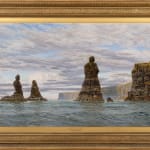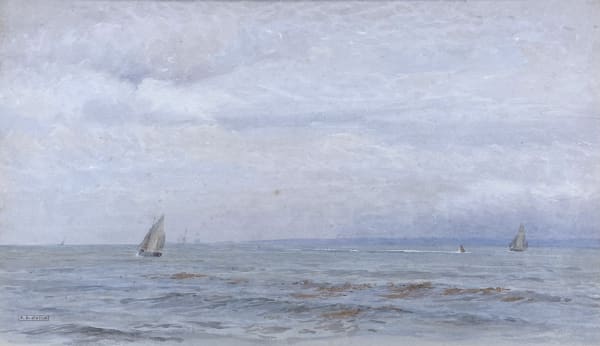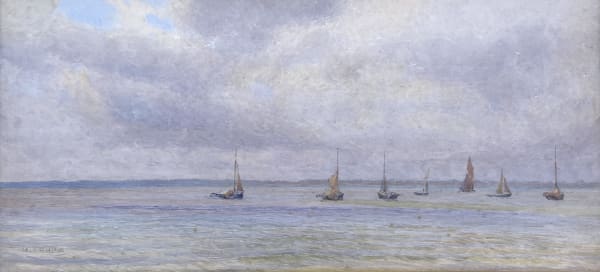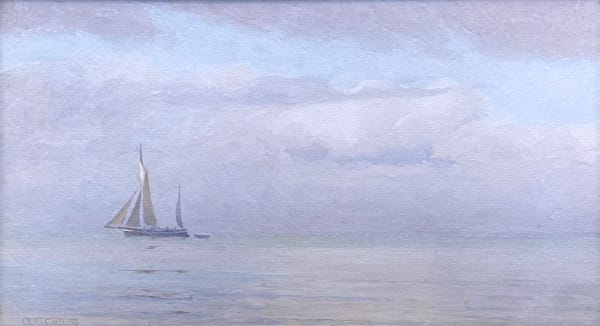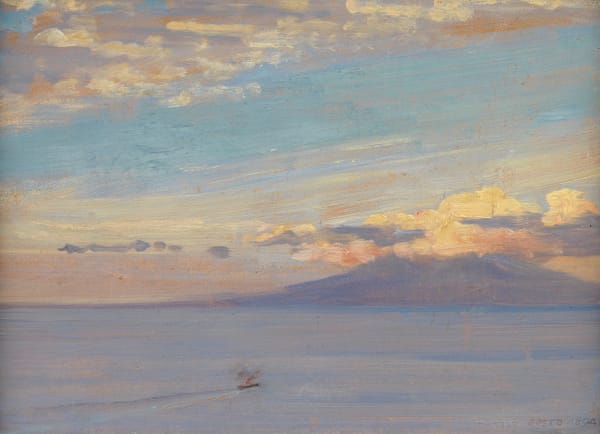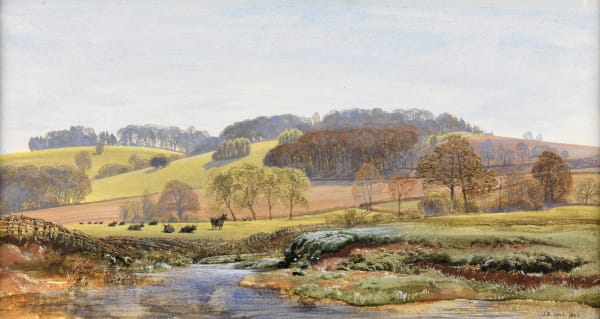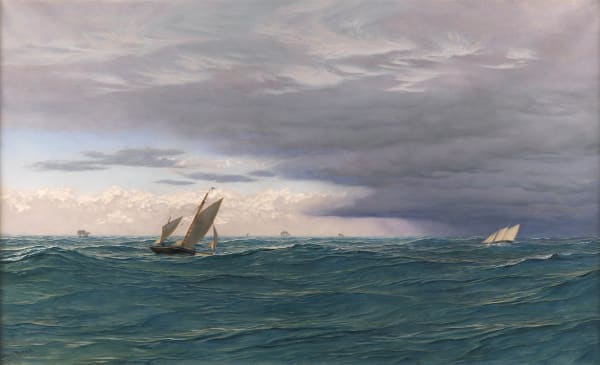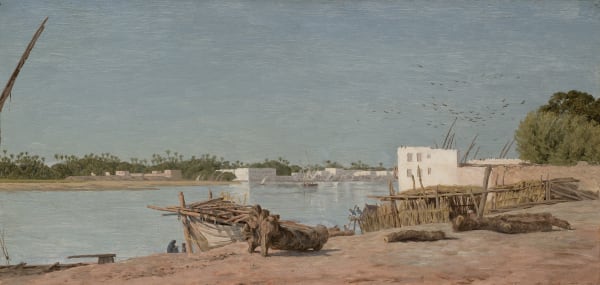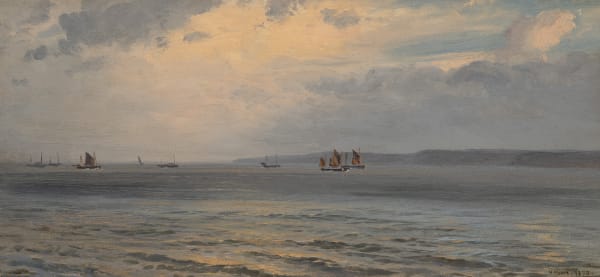John Brett (1831-1902)
Provenance
With Agnew's;
Sold to TJ Hirst 30 May 1884 for £800;
His widow, until 1944;
Higginbotham family, of The Grange, Perton, near Wolverhampton;
Fred Cooper, and thence by descent
Exhibitions
Royal Academy 1884, no. 395;
Leeds, 1888, no. 442
Huddersfield, 1893
Literature
Blackburn's Academy Notes, 1884, ill p 38
Birmingham Daily Post, 6 May 1884
Aberdeen Weekly Journal, 16 May 1884
Athenaeum, 7 June 1884, p 734
Art Journal, 1884 p 211
Magazine of Art, 1884 p 394
Leeds Mercury, 3 Nov 1888
Huddersfield Daily Chronicle, 2 Oct 1893
Christiana Payne: John Brett, Yale UP, 2010, pp.150, 228, Cat no 1051
This is one of the more ambitious pictures that Brett painted at the peak of his success, from studies made aboard his schooner Viking, which he used as a floating studio. In June of 1883, he set off with his wife, seven children and a crew of twelve on a voyage which took them up the west coast of the British Isles, round the north of Scotland, and down the east coast, ending up at Brightlingsea in mid-October, sketching as he went from a specially constructed deck-house studio. By the end of August they had reached the Isle of Skye. The entry in the ship’s log for 1st September records: ‘Many pencil sketches & sketch [in oil] of Macleod’s Maidens.’ As a coastal painter with an interest in geology, he seems to have preferred low tide (much more interesting), but here his boat was anchored at close to high tide just off Ru Idrigill on Skye, to catch the Maidens at their best, standing in the sea. Close observation from the boat enabled Brett to capture this unique view of the awesome natural phenomena, up to 65m high with their semi-human forms, which few had ever seen, especially from this viewpoint. The Viking was anchored in mud and rock in, at the very least, 15m of water – deep even for a 210 ton vessel in unusually calm weather (at least 45m of chain would have been necessary). It is sure that they did not overnight here. Working up in his studio from sketches, Brett produced this dramatic painting in time for the Royal Academy in 1884. The fine original frame was made for Brett by Dolman & Son of Soho. Something of the precariousness of the artist’s position on the storm-battered coast of Skye seems to have attached to the painting, and it attracted several positive notices, the most fulsome of which was in the Pall Mall Gazette: ‘The most striking of Mr. Brett’s pictures is “Macleod’s Maidens”. This represents a scene which very few Scottish travellers have witnessed, for the excellent reason that there is no way of approaching it except by private yacht or steamer. The “Maidens” are three inaccessible columnar rocks on the desolate westerly coast of Skye. The spectator in Mr. Brett’s picture stands on an imaginary vessel in the middle of the mouth of Loch Bracadale, and looks north. He sees the elegant and stately “Maidens,” marvellously human, in front of him, with the extremity of the point of Idrigill to the right, on the same plane, while behind them the coast of Skye trends away, more and more shadowy, till it closes in Copnahow before shelving away to Loch Pooltiel. The two outer “Maidens” bend towards one another, with supple bodies and heads erect, like two coquettish mermaids; the inner one, with her alternate flounces of pale calcareous deposit and black basalt, seems walking on the water as if she were strolling down Bond-street. These insular rocks supply some of the most interesting and peculiar forms which the columnar basalt takes in its course from Antrim to the Quiraing. Mr. Brett has represented the wild scene under a sky of light and high but voluminous cloud, with a broken sea, less radiant in colour than his favourite beryl and amethystine seas of Cornwall. The forms of the “Maidens” are so striking in their isolation that the picture looks more like a figure-piece than a landscape.’
The rocks are associated with many ancient legends: ‘The Maidens themselves are three great rocks rising up out of the sea, a mother and her two daughters. At their feet the mermaids sit and comb their hair: very few see them but many hear their soft, unforgettable singing …. The largest of the Maidens, in shape and general appearance, is not unlike the statues of Queen Victoria seated when seen from the sea. She is the Mother (Nic Cleosgeir Mhor) and is said to be perpetually weaving, while one daughter fulls or thickens and the other does nothing at all. Perhaps they are shadows of the old Norse Fates, the Nornir, two of whom spun the threads which are the lives of men, but the third did nothing except cut them when she chose, for she is blind’ (Otta F Swire, Skye: The Island and its Legends, 1961, pp 150-1).
-
 Alma Claude Burlton Cull (1880-1931)A Grey Day in the Solent£1,800
Alma Claude Burlton Cull (1880-1931)A Grey Day in the Solent£1,800 -
 Alma Claude Burlton Cull (1880-1931)Sailing Boats at Anchor£1,800
Alma Claude Burlton Cull (1880-1931)Sailing Boats at Anchor£1,800 -
 Alma Claude Burlton Cull (1880-1931)A Still Morning£1,800
Alma Claude Burlton Cull (1880-1931)A Still Morning£1,800 -
 Harold Speed (1872-1957)Vesuvius from Capri£6,500
Harold Speed (1872-1957)Vesuvius from Capri£6,500 -
 Henry Moore (1831-1895)Sunset on the Coast£4,800
Henry Moore (1831-1895)Sunset on the Coast£4,800 -
 James Whitelaw Hamilton (1860-1932)Evening on the ClydePOA
James Whitelaw Hamilton (1860-1932)Evening on the ClydePOA -
 William Lionel Wyllie (1851-1931)The Sea-Beach after a Storm - Time, DawnPOA
William Lionel Wyllie (1851-1931)The Sea-Beach after a Storm - Time, DawnPOA -
 John Brett (1831-1902)Springtime near Norbury£10,000
John Brett (1831-1902)Springtime near Norbury£10,000 -
 John Brett (1831-1902)Yachts in a Seaway, MediterraneanPOA
John Brett (1831-1902)Yachts in a Seaway, MediterraneanPOA -
 John Brett (1831-1902)Sunset off Lundy IslandPOA
John Brett (1831-1902)Sunset off Lundy IslandPOA -
 John Brett (1831-1902)Newquay, CornwallPOA
John Brett (1831-1902)Newquay, CornwallPOA -
 Arthur Ditchfield (1842-1888)A View of the Nile, near Cairo£6,800
Arthur Ditchfield (1842-1888)A View of the Nile, near Cairo£6,800 -
 Henry Moore (1831-1895)SeascapePOA
Henry Moore (1831-1895)SeascapePOA -
 Joseph Arthur Palliser Severn (1842-1931)Sunset over Esthwaite Water
Joseph Arthur Palliser Severn (1842-1931)Sunset over Esthwaite Water
The Maas Gallery, 6 Duke Street, St. James's, London, SW1Y 6BN
+44 (0) 20 7930 9511 | mail@maasgallery.com
This website uses cookies
This site uses cookies to help make it more useful to you. Please contact us to find out more about our Cookie Policy.



